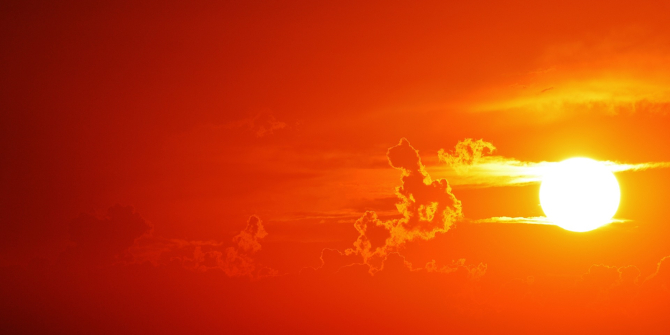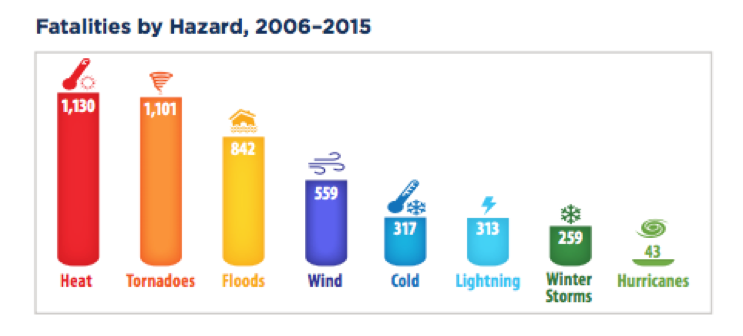While the UK was basking in ‘glorious sunshine’ during July and early August, the other side of the World was not having such a good time.

We have now entered the era in which the impacts of climate change are being felt, with disastrous consequences – and the situation will continue to increase in intensity over the coming years.
Climate change skeptics (commonly known as “the ignorant”) often suggest that a warmer world would not be a bad thing. Unsurprisingly, those that share this view are predominantly from the northern hemisphere where it is not only slightly colder, but live in the luxury of established economies which were built on the exploitation of climate changing fossil fuels.
People in the developing south do not share the same perspective.
Africa is feeling the pain of Climate change
The UNFCCC report on Climate change: Impacts, vulnerabilities and adaptation in the developing world, states that in Africa alone “220 million are exposed to drought each year”. But climate change is not just about droughts, the report explains:
As a result of global warming, the climate in Africa is predicted to become more variable, and extreme weather events are expected to be more frequent and severe, with increasing risk to health and life. This includes increasing risk of drought and flooding in new areas and inundation due to sea-level rise in the continent’s coastal areas.
Africa will face increasing water scarcity and water conflicts. Agricultural production relies mainly on rainfall for irrigation and will be severely compromised in many African countries, particularly for subsistence farmers and in sub-Saharan Africa. Under climate change much agricultural land will be lost, with shorter growing seasons and lower yields, which will further exacerbate poverty and hunger.
Africa is vulnerable to a number of climate sensitive diseases including malaria, tuberculosis and diarrhoea and migration of the malaria mosquito to higher altitudes will expose large numbers of previously unexposed people to infection… stresses and vulnerabilities such as HIV/AIDS and infectious diseases will increase.
Climate change is an added stress to already threatened habitats, ecosystems and species in Africa. Up to 50 per cent of Africa’s total biodiversity is at risk due to reduced habitat and other human-induced pressures.
Future sea level rise has the potential to cause huge impacts on the African coastlines including the already degraded coral reefs on the Eastern coast. Coastal infrastructure in 30 percent of Africa’s coastal countries, is at risk of partial or complete inundation due to accelerated sea level rise.

Drought in Malawi has caused millions of people to go hungry
It is not a pretty picture. So, while people in the west joke about growing olives in England, the wine regions moving north and how nice it is to have a lovely warm summer, we would do well to remember that it is our nations that have burned the fossil fuels which have created the greenhouse effect which is driving this change. It is our legacy, which we are responsible for, which is destroying the environment, and threatening the livelihoods of millions of people.
Climate change has doubled risk of extreme heat waves
In a recent BBC debate on the subject, the panel agreed “extreme heat is becoming more common”. We’re experiencing extreme heat in different geographic locations at the same time. Matt McGrath reported that “scientists have concluded that climate change has doubled risk of extreme heat waves in Europe” and that “the severity of this year’s heat waves has alarmed scientists”. This is runaway global warming (which we were warned about in the 1980s), in action.
The impact on the food chain terrifies James Murray, from Business Green, who can see reduced yields, intensified soil erosion and desertification as becoming real issues.
“We know 16 of the 17 hottest years on record have been since 2000. We know the world has not experienced temperatures below the 20th century average since 1976. We know with a high degree of confidence that unless we build a net zero emission economy within decades we risk temperature increases in excess of 2C that could have catastrophic consequences. We know these consequences could lead to food security and migratory pressures that makes the current debate about migration look like a golden age of genteel deliberation.” Says James.
Joanna Haigh, Co-Director of the Grantham Institute for Climate Change, sees severe health risks from climate change and extreme heat which will lead to spikes in death rates and increased risk of migration. Such events are much more likely as the planet warms, she warns.
Air conditioning is exacerbating Climate change
Nick Loris, Economist at the Heritage Foundation, is concerned about the financial cost of heat due to wild fires and losses to the agricultural sector. He also highlights increases in electricity use for air conditioning as a significant problem and how this hits low income groups hardest.
The economist reports that improving the efficiency of air-conditioners is the single most effective way to reduce greenhouse-gas emissions:
“Replacing refrigerants that damage the atmosphere would reduce total greenhouse gases by the equivalent of 90bn tonnes of CO2 by 2050. Making the units more energy-efficient could double that. By contrast, if half the world’s population were to give up meat, it would save 66bn tonnes of CO2. Replanting two-thirds of degraded tropical forests would save 61bn tonnes.”
TIME Magazine reported that roads have been melting in Australia causing three inch of tarmac to stick to truck tires but, more significantly, Climate Reality have detailed how “Extreme heat is more deadly than any other weather-related hazard“.
Extreme heat is more deadly than any other weather-related hazard
Most directly, extreme heat impacts human health in three significant ways: Heat cramps, Heat exhaustion and Heat strokes.
“Like most climate impacts, heatwaves don’t affect all people the same way. Young children, the elderly, the poor, and people with preexisting conditions (like respiratory disease or diabetes) are the most at risk when exposed to extreme heat.” Climate Reality

Number of fatalities by hazard (2006–2015) in the US. Source: Center for Disease Control, Climate Change and Extreme Heat: What You Can Do to Prepare
In 2003, more than 2,000 people died in the UK alone – during what turned out to be its hottest summer in more than 500 years across the western part of the continent. Lord John Krebs, the UK’s chair of the Committee on Climate Change (CCC)’s adaptation sub-committee, told the Guardian:
“What we now think of as an extremely hot summer, where people are dying of heat stress … is likely to be a typical summer by the middle of the century and would be a cool summer in the 2080s.”
Climate change is killing agriculture
“Already 85% of the rich peat topsoils of East Anglia has disappeared,” said Krebs, due to drainage and erosion. “We have lost a lot of the natural asset that allows us to grow cereals and climate change will accelerate the rate of loss. We could lose the remaining fertile soil within the next 30-60 years and that would be a huge negative impact on the food production capacity of the UK.”
And that’s just in the UK – imagine how much more severe the impacts will be in Africa!
Karla, our Operations Director in Zambia, reports that they have had the coldest winter in 10 years and, as we have previously highlighted, the frequent droughts in Zambia and Malawi have caused huge impact on local economies and caused people to go hungry. In December 2016, we reported that 6.5 million Malawians – over 30 per cent of the population – were facing a lack of food and the increasing impacts of climate change are not improving the situation.
The Zambian Meteorological Department reports that:
“Continued suppression of rainfall, accompanied by anomalously high temperatures throughout many parts of Zambia especially over the southern half has led to substantial moisture deficits and an increased likelihood for adverse crop impacts. The abnormal dryness has strengthened and expanded and is likely to continue for the rest of January placing additional moisture stress on crops.”
But…
“Even though the southern half of the country is expected to receive below normal rainfall, flash floods may still occur due to the likelihood of high intensity rainfall events.”
In Zambia, any change in climate can spell disaster. With a majority of Zambians depending on agriculture, even a slight change in temperature can affect crops like maize with catastrophic consequences for livelihoods.
Agriculture in Zambia accounts for 18-20 percent of the country’s gross domestic product, employs approximately two-thirds of the country’s labor force, and is a key source of livelihoods for 50 percent of the country.
Climate change impacts on agriculture in Zambia
USAID’s Climate Change Adaptation in Zambia Fact Sheet reports that:
“The rising frequency of drought and shorter rainy seasons has led to increasing crop loss and food insecurity. Higher temperatures and greater frequency of drought may also degrade grazing land and lead to loss of livestock, with negative consequences for food security. Floods from heavy rainfall events are also threatening food production, particularly in northern Zambia. Recorded effects of past floods on agriculture include inundation of farmland, destruction of crops, increased malnutrition and hunger, soil erosion, reduced cultivatable land, and loss of livestock.”
Climate change is real and its effects are here and now. We need to more to address the causes which means deploying more renewable energy faster, in all regions of the world and decarbonising our economies as a matter of urgency.
Amongst other “priority challenges” including “Developing clear and specific legal and policy frameworks for climate change to help direct adaptation planning”, which clearly has not worked to date. USAID also suggests “Increasing public awareness on climate change and its potential impacts on social and economic development, livelihoods, and ecosystems”.
SolarAid’s commitment to addressing the challenge
No-one is doing enough to address these fundamental issues. The Sustainable Development Goals were set up specifically to encourage progress towards a sustainable future and goal 13 specifically calls for “Climate Action”, encouraging everyone to “take urgent action to combat climate change and its impact”. SolarAid’s purpose is to address poverty (SDG1) and climate change (SDG13) through the provision of renewable energy (SDG7). In total our activities, setting up networks of sales agents who distribute solar light, address 12 of the 17 SDGs.
![]()
We’re completely committed to solving the SDGs and are trying everything we can however, like our CEO, John Keane says:
“If you haven’t got electricity access in rural areas, you’re tying your hands behind your back in trying to solve all the SDGs”.
This is why we are so focussed on SDG7, which aims to “Ensure access to affordable, reliable, sustainable and modern energy for all” by 2030. We know this can be achieved. We have the technological solutions, we have the delivery strategies and knowledge to ensure no-one is left in the dark. All we are missing are the funds to develop the partnerships and programmes to deliver the solutions we have tried and tested – we know they work!
Our latest range of strategies at SolarAid target households, schools and clinics in Zambia and Malawi to ensure energy access for all – so that no one is left in the dark. We’re also working to open source our models, to provide others with the knowledge to replicate our work in other countries.
What can you commit?
If you’re anywhere near as worried as we are about the effects of climate change please consider sharing this article to help raise public awareness. If you’re able to contribute to SolarAid’s work on fighting climate change and pushing for sustainable, renewable solutions across Africa, please also consider supporting our work.